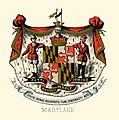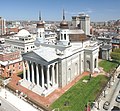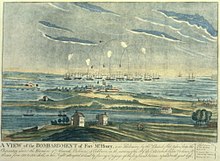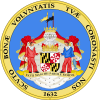|
Maryland Portal
|
Baltimore Task Force
|
Frederick Task Force
|
Montgomery Task Force
|
WikiProject Maryland
|
|
Main page
|
Discussion
|
Introduction Maryland (US: /ˈmɛrɪlənd/ MERR-il-ənd) is a state in the Mid-Atlantic region of the United States. The state borders Virginia to its south, West Virginia to its west, Pennsylvania to its north, Delaware to its east, the Atlantic Ocean, and the national capital of Washington, D.C. With a total area of 12,407 square miles (32,130 km2), Maryland is the ninth-smallest state by land area, and its population of 6,177,224 ranks it the 18th-most populous state and the fifth-most densely populated. Maryland's capital is Annapolis, and the most populous city is Baltimore. Occasional nicknames include Old Line State, the Free State, and the Chesapeake Bay State. It is named after Henrietta Maria, the French-born queen of England, Scotland, and Ireland during the 17th century. Maryland's coastline was first explored by Europeans in the 16th century. Prior to that, it was inhabited by several Native American tribes, mostly the Algonquian peoples and, to a lesser degree, Iroquoians and Siouans. As one of the original Thirteen Colonies, Maryland was founded by George Calvert, 1st Baron Baltimore, a Catholic convert who sought to provide a religious haven for Catholics persecuted in England. In 1632, Charles I of England granted Lord Baltimore a colonial charter, naming the colony after his wife, Henrietta Maria. Unlike the Pilgrims and Puritans, Lord Baltimore envisioned a colony where people of different religious sects would coexist under the principle of toleration. In 1649, the Maryland General Assembly passed an Act Concerning Religion, which enshrined this principle by penalizing anyone who "reproached" a fellow Marylander based on religious affiliation. Nevertheless, religious strife was common in the early years, and Catholics remained a minority, albeit in greater numbers than in any other English colony. Maryland's early settlements and population centers clustered around rivers and other waterways that empty into the Chesapeake Bay. Its economy was heavily plantation-based and centered mostly on the cultivation of tobacco. Demand for cheap labor from Maryland colonists led to the importation of numerous indentured servants and enslaved Africans. In 1760, Maryland's current boundaries took form following the settlement of a long-running border dispute with Pennsylvania. Maryland was an active participant in the events leading up to the American Revolution, and by 1776, its delegates signed the Declaration of Independence. Many of its citizens subsequently played key political and military roles in the war. Although then a slave state, Maryland remained in the Union during the American Civil War, its strategic location giving it a significant role in the conflict. After the Civil War, Maryland took part in the Industrial Revolution, driven by its seaports, railroad networks, and mass immigration from Europe. Since the 1940s, the state's population has grown rapidly, to approximately six million residents, and it is among the most densely populated U.S. states. , Maryland had the highest median household income of any state, owing in large part to its proximity to Washington, D.C., and a highly diversified economy spanning manufacturing, retail services, public administration, real estate, higher education, information technology, defense contracting, health care, and biotechnology. Maryland is one of the most multicultural states in the country; it is one of the six states where non-Whites compose a majority of the population, with the fifth-highest percentage of African Americans, and high numbers of residents born in Africa, Asia, Central America, and the Caribbean. The state's central role in U.S. history is reflected by its hosting of some of the highest numbers of historic landmarks per capita. (Full article...) This is a Featured article, which represents some of the best content on English Wikipedia..
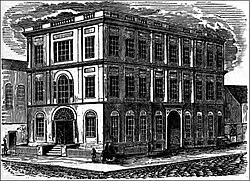 The history of The Baltimore City College began in March 1839, when the City Council of Baltimore, Maryland, passed a resolution mandating the creation of a male high school with a focus on the study of English and classical literature. "The High School" (later becoming The Baltimore City College) was opened later in the same year on October 20, with 46 pupils under the direction of Professor Nathan C. Brooks,(1809-1898), a local noted classical educator and poet, who became the first principal of a new type of higher institution in the developing public education system in the city begun in 1829. It is now considered to be the third oldest public high school / secondary school in the nation. In 1850, the Baltimore City Council granted the school, then known as the "Central High School of Baltimore", the authority to present its graduates with certificates of completion. An effort to expand that academic power and allow the then named "Central High School of Baltimore" to confer Bachelor of Arts degrees began following the Civil War in 1865, and continued the following year with the renaming of the institution as "The Baltimore City College", which it still holds to this day, with also the retitling of its chief academic officer from "principal" to "president", along with an increase in the number of years of its course of study and the expansion of its courses. However, despite this early elevation effort, it ended at that brief period unsuccessfully in 1869, although the B.C.C. continued for a number of years as a hybrid public high school and early form of junior college (later known as community college) which did not fully appear in America in different form until the beginning of the 20th century. Very often the elaborate decorative fancy engraved graduation diploma from the B.C.C. in the late 19th and early 20th centuries was accepted by many other colleges and universities entitling City graduates to enter upper-division schools at the sophomore year, (which was also coincidentally a privilege also accorded to its later local academic and athletic rival for 127 years - "Poly", the Baltimore Polytechnic Institute, founded 1883 as the Baltimore Manual Training School, later renamed 1893). As the importance of higher education increased in the early 20th century, the High School's priorities shifted to preparing students for college. In 1927, only one year before the school moved from its home at Howard and Centre Streets for 53 years to the magnificent stone "Castle on the Hill" on "Collegian Hill", the academic program was further changed, when the City College divided its curriculum into two tracks: the standard college preparatory program, or "'B' Course", and a more rigorous stiff "Advanced College Prep" curriculum, the famed "'A' Course" of study focusing on humanities, social studies, liberal arts and the Classics. (also available in the mathematics/science/technology fields in a more structured form with little options/electives at "Poly" and at Western and Eastern High Schools for girls). (Full article...)General imagesIn the news
On this day...The Maryland portal currently doesn't have any anniversaries listed for June 1. You can help by viewing the page source of an existing entry at /On this day to see how the entries should be formatted, then adding the missing entry. This is a Good article, an article that meets a core set of high editorial standards.
Eva Marie Cassidy (February 2, 1963 – November 2, 1996) was an American singer and musician known for her interpretations of jazz, folk, and blues music, sung with a powerful, emotive soprano voice. In 1992, she released her first album, The Other Side, a set of duets with go-go musician Chuck Brown, followed by the 1996 live solo album titled Live at Blues Alley. Although she had been honored by the Washington Area Music Association, she was virtually unknown outside her native Washington, D.C., at the time of her death from melanoma at the age of 33 in 1996. Two years after her death, Cassidy's music was brought to the attention of British audiences, when her versions of "Fields of Gold" and "Over the Rainbow" were played by Mike Harding and Terry Wogan on BBC Radio 2. Following the overwhelming response, a camcorder recording of "Over the Rainbow", taken at Blues Alley in Washington by her friend Bryan McCulley, was shown on BBC Two's Top of the Pops 2. Shortly afterwards, the compilation album Songbird climbed to the top of the UK Albums Chart, almost three years after its initial release. The chart success in the United Kingdom and Ireland led to increased recognition of Cassidy worldwide. Her posthumously released recordings, including three number-one albums and one number-one single in the UK, have sold more than ten million copies. Her music has also charted within the top 10 in Australia, Germany, Norway, Sweden and Switzerland. (Full article...)Selected article -The Battle of Baltimore (September 12–15, 1814) took place between British and American forces in the War of 1812. American forces repulsed sea and land invasions off the busy port city of Baltimore, Maryland, and killed the commander of the invading British forces. The British and Americans first met at the Battle of North Point. Though the Americans retreated, the battle was a successful delaying action that inflicted heavy casualties on the British, halted their advance, and allowed the defenders at Baltimore to prepare for an attack. (Full article...)Did you know?

SubcategoriesSelect [+] to view subcategories
TopicsRelated portalsAssociated WikimediaThe following Wikimedia Foundation sister projects provide more on this subject:
Discover Wikipedia using portals |



















